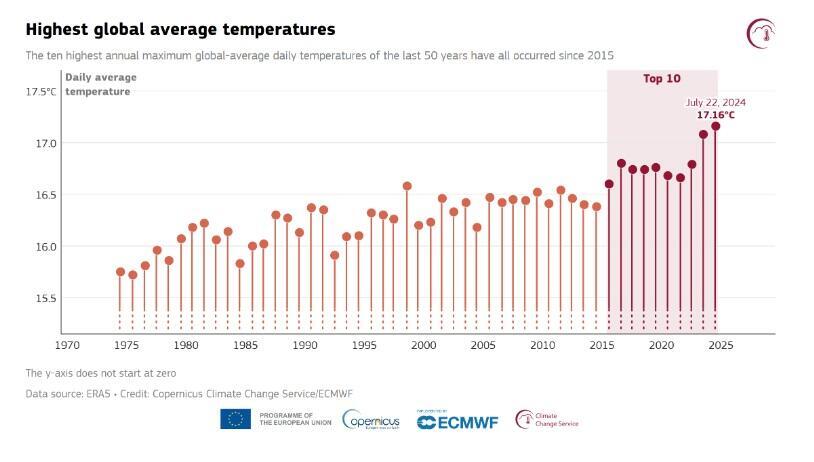Getting your Trinity Audio player ready...
On July 22, 2024, the Earth's average temperature reached 17.16°C (63.89°F). While this may not seem particularly high, it is the highest daily average temperature ever recorded. It surpassed the previous record of 17.09°C, which lasted only one day after being set on July 21, and other, earlier records, all of which were set in July 2023.
The primary driver behind the rapid pace of temperature record-breaking is climate change. Since the late stages of the First Industrial Revolution in the 18th-century, and at an accelerating pace since the late 20th century, human activity has been responsible for a sharp increase in the concentration of greenhouse gasses in the atmosphere, particularly carbon dioxide released from burning fossil fuels like oil and natural gas. As atmospheric greenhouse gas levels continue to rise, we can expect Earth's temperatures to follow suit.
An uneven pace
If the amount of greenhouse gasses in the atmosphere increases steadily, and we know that the higher their concentration, the warmer the atmosphere, why don't daily temperatures rise continuously from day to day? To answer this question, we must first understand the difference between weather and climate.
Weather reflects the short-term state of the atmosphere in a particular place and can change from day to day, even hour to hour. In the U.S. winter, for example, New York might experience a day of heavy snow and freezing temperatures, followed by a milder, sunny day. On a summer day, San Francisco might be cool and foggy, while just a short drive inland, places like Walnut Creek or Napa Valley can be hot and sunny. However, from a broader perspective, if we examine average weather conditions – temperature, precipitation, and seasonal changes – over several decades, we observe relatively consistent patterns. This is what defines the climate of a particular region.
This distinction is key to understanding which parameters are likely to change with the increase in greenhouse gasses and to identifying climate changes. The larger the area measured and the longer the period, the more accurately we can detect climate changes resulting directly from increased greenhouse gas, without being skewed by localized weather conditions at a specific place or time. Long-term measurement data show that not only have the hottest day records been broken in the last two years, but also the hottest month (July 2024) and the hottest year (2023).
2 View gallery


Temperature records have been repeatedly broken in recent years. Highest daily average temperatures over the last 50 years
(Photo: ERA5, Graph Source: C3S/ECMWF)
Why do temperature records usually get broken in July and August? Although during this period summer in the Northern Hemisphere is at its peak, in the Southern Hemisphere, it's the height of winter. The explanation lies in Earth's continental structure. The heat capacity of ocean water is higher than that of land, so land areas heat up and cool down faster than maritime regions. Since most of Earth's landmass is in the Northern Hemisphere, the global average temperature is higher during the Northern Hemisphere's summer months – July and August.
To understand why temperature records were broken specifically in 2023 and 2024, we need to consider the El Niño cycle. El Niño is a climate cycle that influences temperature, precipitation, and wind patterns across large parts of the Earth, particularly around the Pacific Ocean, the largest body of water on our planet. During "El Niño years," the upwelling of cold, deep water to the ocean's surface in the central and eastern Pacific weakens compared to normal and "La Niña years," when the trend reverses. As a result, sea surface temperatures, and consequently, global average temperatures, rise. Both 2023 and 2024 are El Niño years, as was 2016, when the previous annual temperature record was set.
In summary, three main factors contribute to the recent temperature records: human-induced greenhouse gas emissions into the atmosphere, the Northern Hemisphere's summer, and the El Niño cycle. Since we cannot control the latter two factors, it is crucial to reduce greenhouse gas emissions into the atmosphere as quickly as possible before we find ourselves in the midst of a global ecological disaster.
Get the Ynetnews app on your smartphone:


